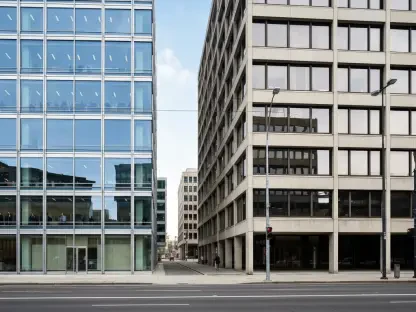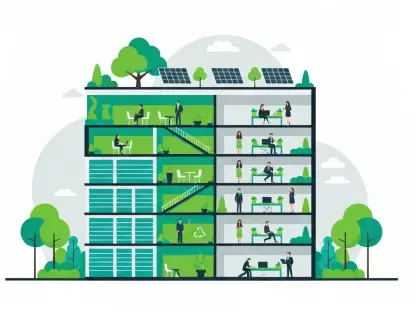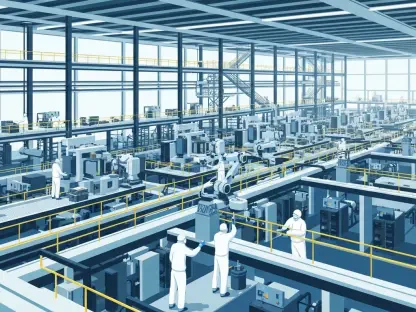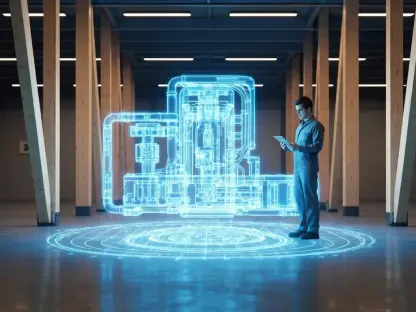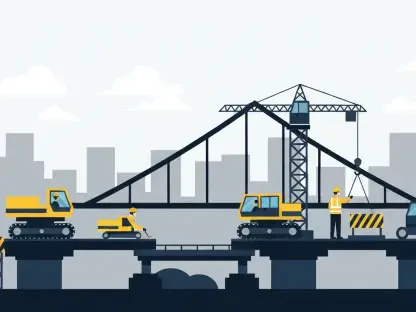Election uncertainty has had a noticeable impact on construction activity leading up to the 2024 presidential race. Business owners’ anxiety is at an all-time high, influencing key sectors such as private construction, while public sector projects remain somewhat insulated from these concerns for the time being.
Small Business Uncertainty
Rising Anxiety Among Small Business Owners
Uncertainty among small business owners across various industries recently reached unprecedented levels, as indicated by the National Federation of Independent Business (NFIB) index. The tight presidential contest exacerbates this anxiety, impacting overall building activity. Granger Hassmann, vice president of preconstruction and estimating at Adolfson & Peterson, noted a market slowdown, particularly in the private sector. This trend, marked by a “let’s see what happens” attitude, has been apparent over the last two years. Many small business owners have adopted a risk-averse approach, delaying projects until they have a clearer understanding of potential policy changes that could affect their operations.
In various regions, the hesitation among small business owners is palpable. The uncertainty surrounding regulatory changes and potential shifts in economic policies has created a challenging environment for securing financing and making long-term investment decisions. The anxiety has cut across multiple sectors, further straining the already burdened supply chains and labor markets. As the election date approaches, the atmosphere of caution among small business leaders shows no signs of abating, which could have a lasting impact on the economic landscape.
Economic Commentary and Market Slowdown
The Federal Reserve Bank of Cleveland’s Beige Book report highlights that commercial builders are waiting until post-election to proceed with construction projects. Similarly, the Federal Reserve Bank of New York observes a moderate decline in construction activity within its jurisdiction. Architectural firms, typically early indicators of future construction activity, report a slowdown due to election-related uncertainty and evolving economic prospects. Kermit Baker, chief economist at The American Institute of Architects, observed that despite inflation concerns fading and easing interest rates, the anticipated recovery is hindered by election uncertainty.
Architectural firms are on the frontlines of observing these trends, often seeing the effects of election uncertainty before they manifest in larger statistical analyses. As primary planners and designers of future projects, these firms noted a significant slowdown in new commissions and project launches. This sluggishness is attributed to a combination of election-related apprehensions and a cautious business climate shaped by fluctuating economic indicators. The prevailing sentiment among architects and builders suggests that the industry is bracing for a more stable post-election period, where definitive results could either bolster confidence or necessitate rapid adjustments to new regulatory and economic realities.
Project Delays and Financial Hesitations
Delayed Projects Reflect Broader Market Hesitancy
Instances of delayed projects reflect broader market hesitancy. For example, Ultium Cells paused work on a $2.6 billion factory in Lansing, Michigan, due to sluggish demand and high-interest rates, planning to resume when the economic outlook is clearer. Similarly, Shift Capital halted conversion efforts in Philadelphia’s Beury Building as high-interest rates and lender caution made banks wary of large project commitments. Michael Guckes, chief economist at ConstructConnect, attributes this cautious approach to the uncertain policy environment post-election.
These project delays are symptomatic of a broader trend where developers and financiers exhibit caution in the face of uncertain political and economic futures. The high costs of capital and stringent lending criteria have made large-scale projects untenable for the time being. Construction firms are finding it increasingly challenging to secure financing, further exacerbating the slowdown. This environment of financial hesitance is not just confined to a few isolated incidents but is reflective of a systemic issue that could have lasting ramifications on the construction industry’s momentum and growth prospects post-election.
Financial Constraints and Policy Environment
The uncertain policy environment post-election is a significant factor affecting construction activity. Guckes emphasizes the potential for numerous “divided government” scenarios affecting construction activity. This cautious approach is evident in the financial hesitations seen across various projects, reflecting broader market trends and the impact of election uncertainty on financial decisions. As businesses brace for potential shifts in policy, the construction sector faces an unreliable landscape where securing long-term investments becomes increasingly fraught with risks.
The financial constraints imposed by this uncertain environment have led to a reevaluation of project viability and timelines. Developers are postponing initiatives, anticipating that post-election clarity might bring more favorable financial conditions or policy frameworks. The apprehension extends to lenders, who are now more reserved in their commitments, further tightening the capital availability for construction projects. The prevailing mood suggests that until the political landscape stabilizes, the construction sector will remain in a state of cautious anticipation, affecting both short-term and long-term planning across the industry.
Better Prospects in Public Sector
Resilience of Public Sector Projects
Infrastructure and public sector projects are faring better. Ken Simonson, chief economist at the Associated General Contractors of America (AGC), notes that public construction projects, such as infrastructure, schools, and utility endeavors, enjoy a longer lead time and are generally immune to election uncertainty. AGC members report no election-related hold-offs in public construction. However, political changes could reshape specific public funding packages.
Public sector projects benefit from more extended planning horizons and guaranteed funding, shielding them from the immediate impacts of election-driven economic volatility. These initiatives, critical for community well-being and economic stability, continue unabated, ensuring that essential services and infrastructure needs are met. The resilience of public sector projects underscores the importance of stable and predictable funding mechanisms, which serve as a buffer against the uncertainties that typically beleaguer the private sector as elections approach.
Impact of Political Changes on Public Funding
Anirban Basu, chief economist at Associated Builders and Contractors, points out that massive subsidies in the CHIPS Act and Inflation Reduction Act for manufacturers and alternative energy producers may be substantially altered by an administrative change. For example, solar cell manufacturer Meyer Burger shelved its $400 million project in Colorado due to financial constraints tied to the Inflation Reduction Act and the uncertain economic environment—a situation reflected in reduced potential debt financing for its construction.
The potential for administrative changes introduces a layer of unpredictability to public sector projects. While current endeavors proceed with stability, shifts in political priorities can lead to significant adjustments in funding allocation. The example of Meyer Burger highlights how uncertainties around policy continuity can impact financial planning and project execution. Stakeholders in the public construction sphere must remain vigilant, anticipating and preparing for possible legislative changes that could reshape the funding landscape and alter the trajectory of large-scale projects.
Economic Factors and Future Projections
Construction Material Costs and Economic Trends
Despite a 39% increase in construction material costs since the pandemic onset, recent price stability has emerged, facilitated by declining energy prices. However, Basu warns that renewal of trade tensions, especially tariffs on China, could raise construction costs through inflationary pressures, potentially pushing interest rates higher—an outcome contractors hope to avoid. Different party control scenarios present contrasting impacts on the construction industry.
The fluctuation in material costs has been a significant challenge for the construction industry, complicating budgeting and project planning. While recent stabilization offers temporary relief, the looming threat of trade tensions and tariffs presents a potential disruptor. Contractors and developers must stay attuned to global economic trends, preparing for scenarios where material costs could once again escalate. This vigilance is crucial for maintaining financial health and ensuring project feasibility in an unpredictable economic environment.
Political Outcomes and Their Impacts
A Trump Presidency with a Republican Congress would likely lead to heightened deficit spending, lower corporate taxes, and increased tariffs, producing mixed near-term growth and potential inflation. This mirrors the Federal Reserve’s 2022-2023 anti-inflation strategies, potentially resulting in another period of higher interest rates, impacting owners’ and developers’ financing capacity negatively. Conversely, a Harris Administration with a Democratic Congress would likely avoid aggressive near-term spending while possibly imposing stricter environmental and labor regulations. Although this approach might stave off worst-case inflation scenarios, it could also impede construction pace and inflate costs.
The varying political outcomes each present unique implications for the construction industry. The possibility of heightened deficit spending under a Trump administration could spur short-term growth but at the cost of long-term financial stability, potentially leading to higher interest rates. On the other hand, a Harris-led administration may focus on sustainable practices, leading to higher regulatory costs but also fostering a stable economic environment. The industry’s stakeholders will need to adapt their strategies to align with whichever outcome materializes, balancing growth opportunities with regulatory compliance and economic sustainability.
Overarching Trends and Consensus
Delays and Hesitancy in the Private Sector
Uncertainty surrounding the 2024 elections, marked by cautious market behavior, has slowed down private sector projects. This trend is prevalent across various regions and sectors. The mood of caution, driven by a tight presidential race, is leading many developers to adopt a wait-and-see approach, delaying critical projects. The pervasive hesitation continues to impact new ventures, with stakeholders preferring to delay investments until after the election results are clear.
In various sectors, the apprehension stems from concerns over potential shifts in regulatory frameworks and economic policies that could affect profitability and project viability. This cautious approach is especially evident in high-stakes projects where financial and material investments are substantial. The broader economic sentiment further exacerbates this trepidation, as industry leaders weigh the risks of moving forward against the backdrop of a highly unpredictable political climate. This collective hesitance is likely to continue until there is greater clarity on the post-election policy landscape.
Continued Momentum in Public Projects
In contrast to the private sector, public projects, especially those with substantial lead times like infrastructure and educational facilities, are advancing relatively unaffected by the election jitters. Public sector projects continue marching forward, cushioned by their long lead times and structural necessities. These projects, being less vulnerable to immediate political fluctuations, provide a sense of continuity and stability in the midst of broader economic uncertainties.
The sustained momentum in public projects is crucial for community development and economic resilience, providing essential services and infrastructure improvements that support societal well-being. The insulation from election-related volatility underscores the importance of secure and predictable funding sources for public projects. This stability enables policymakers and project managers to focus on long-term planning and execution, ensuring that critical infrastructure needs are met regardless of the election outcomes.
Main Findings
Election uncertainty is evidently weighing on the construction industry, primarily within the private sector. This mood of caution, driven by a tight presidential race, is leading many developers to adopt a wait-and-see approach, delaying critical projects. Economic reports from authoritative bodies such as the Federal Reserve’s Beige Book provide corroborating evidence of this trend. On the other hand, public sector projects continue marching forward, cushioned by their long lead times and structural necessities. Nonetheless, significant political shifts post-election could disrupt funding mechanisms and introduce new regulatory pressures. The industry, while holding its breath, braces for the outcomes, knowing the profound impacts these shifts could generate.
Conclusions and Synthesis
The uncertainty surrounding the upcoming 2024 presidential election is significantly impacting construction activity. Business owners, feeling a heightened sense of anxiety, are hesitant to make substantial investments in key sectors like private construction. This reluctance stems from concerns over potential changes in policies that could affect the economic landscape. As a result, many private construction projects are seeing delays or cancellations as companies adopt a wait-and-see approach. They’re wary of making financial commitments that could become burdensome if political shifts were to happen.
However, projects within the public sector seem to be somewhat insulated from these election-related anxieties—at least for now. Government-funded construction activities continue to progress, largely because they rely on budgets that have already been approved and are less susceptible to sudden changes in administration or policy. The stability in public sector projects provides a steady flow of construction work, even as private sector activities slow down. This dynamic underscores the broader impact of the political climate on different aspects of the economy, particularly as the nation approaches another critical election cycle.


